Mexico missing students: Knowns and unknowns
- Published
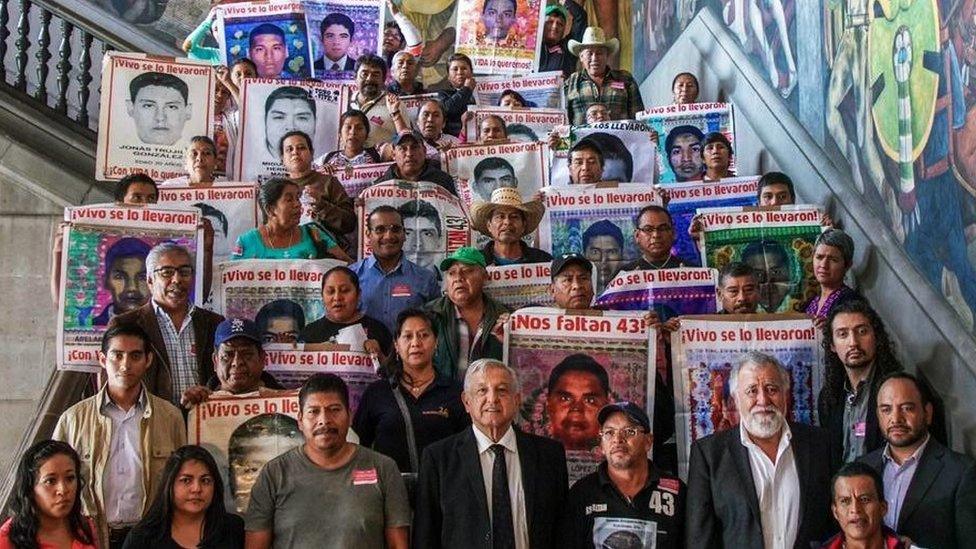
Families of those missing continue to demand answers from successive governments
On the evening of 26 September 2014, a group of 43 Mexican students disappeared in south-western Guerrero state.
The young trainee teachers' disappearance and the botched investigation which followed triggered protests and outrage in Mexico and abroad.
Eight years on, a commission set up to investigate the case described it as "a crime of the state" - but who was behind their abduction and what their motive was remains unclear to this day.
Now, Mexico's former attorney general has been ordered to stand trial in connection with the case.
Here is what we know - and do not know - about the missing students.
Who were they?

All 43 were young, male students at a teacher training college in Guerrero state
The 43 studied at an all-male teacher training college in the town of Ayotzinapa. The college has a history of left-wing activism and the students regularly took part in protests.
What were they doing on the day of their disappearance?

They left their school on 26 September to go to nearby Iguala
The 43 were part of a larger group of trainee teachers from Ayotzinapa who travelled to the nearby town of Iguala to protest against what they saw as discriminatory hiring practices for teachers.
They also wanted to raise funds for a trip they were planning to Mexico City to mark the anniversary of the 1968 Tlatelolco Massacre, when a large number of students were killed by the security forces in the capital.
One member of the group said they were planning on commandeering a number of buses for their trip, although he insisted they would convince the drivers to take them rather than force them.
What happened that night?

Six people, three of them students, were killed the night of 26 September 2014 near Iguala
As they were travelling back from Iguala to Ayotzinapa, they were confronted by municipal police, who opened fire on the buses they were travelling in.
The officers maintain they did so because the buses had been hijacked, while the surviving students say the drivers had agreed to give them a lift.
Police also mistakenly fired on a bus carrying a local football team, killing its driver and one of the players on board. A woman travelling in a nearby taxi was killed by a bullet.
Three students were also killed, two of them shot dead, while the body of the third was found mutilated the next morning near the scene of the shooting.
What about the missing 43?

There have been mass protests by people demanding to know what happened to the missing students
Forty-three of the students were reported missing after the clash with police.
The investigation carried out in the weeks after their disappearance alleged that they were seized by municipal officers and taken to the police station in the nearby town of Cocula.
There, they were handed over by corrupt police officers to members of a local drug gang, Guerreros Unidos (United Warriors), the report said.
The gang then took them to a local rubbish dump in Cocula, where they killed the students and burned their bodies, the report continued. The gang dumped their remains in a nearby stream, it concluded.
However, that report has since been widely discredited, and the attorney general who was in charge of the investigation has been arrested. Jesús Murillo Karam will now go on trial charged with forced disappearance, torture and the obstruction of justice.
Watch: Mexicans react to former attorney general arrest
An arrest warrant has also been issued for the head of the investigation, Tomás Zerón, who has fled Mexico and is thought to be in Israel.
Dozens of police officers and members of the military are also wanted on suspicion of crimes ranging from obstruction of justice to torture and forced disappearance.
Have any of their remains been found?
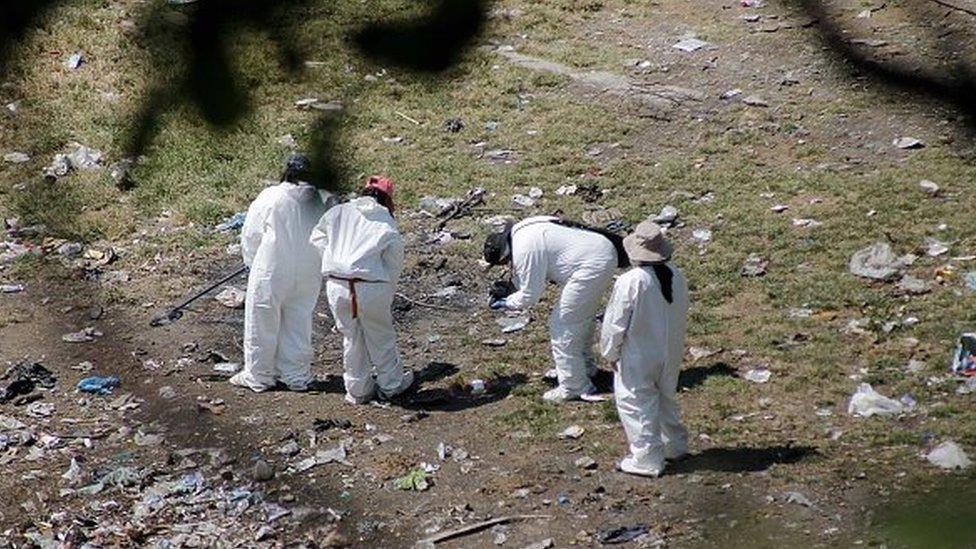
Experts have cast doubts on an official report which said that the students' remains were burned at a rubbish dump
Yes, the remains of three out of the 43 students have been identified by independent experts.
Charred bone fragments found in 2014 were a match to Alexander Mora, who had been 19 at the time of his abduction.
However, the location where his remains were found is disputed. The now-discredited investigation carried out shortly after the students' disappearance claimed that Mora's remains had been discovered at a rubbish dump in Cocula.
But the Interdisciplinary Group of Independent Experts (GIEI) - a group created by the Inter-American Commission of Human Rights (IACHR) and independent of the Mexican government - later said that the chain of evidence had been broken and that it could not be sure Mora's bone fragments came from the dump.
Drone footage recently obtained by the GIEI shows marines tampering with the rubbish dump in Cocula. The marines' visit to the dump had not been recorded in official documents and only came to the GIEI's attention because of the drone footage.
Remains of a foot bone found in 2019 in a ravine near Cocula - some 800m from the rubbish dump - were matched by Austrian forensic specialists to 19-year-old Christian Alfonso Rodríguez.
In the same ravine, investigators had earlier found human remains which years later, in 2021, were conclusively matched to 20-year-old Jhosivani Guerrero de la Cruz.
The theory put forward in the now-discredited government report that the bodies of all the missing students were burned at the rubbish dump in Cocula was dismissed as early as 2016 by Argentine forensic experts, who concluded that there was no biological or physical evidence to indicate that a fire or such proportions had been lit.
If they were not killed in Cocula, where are they?
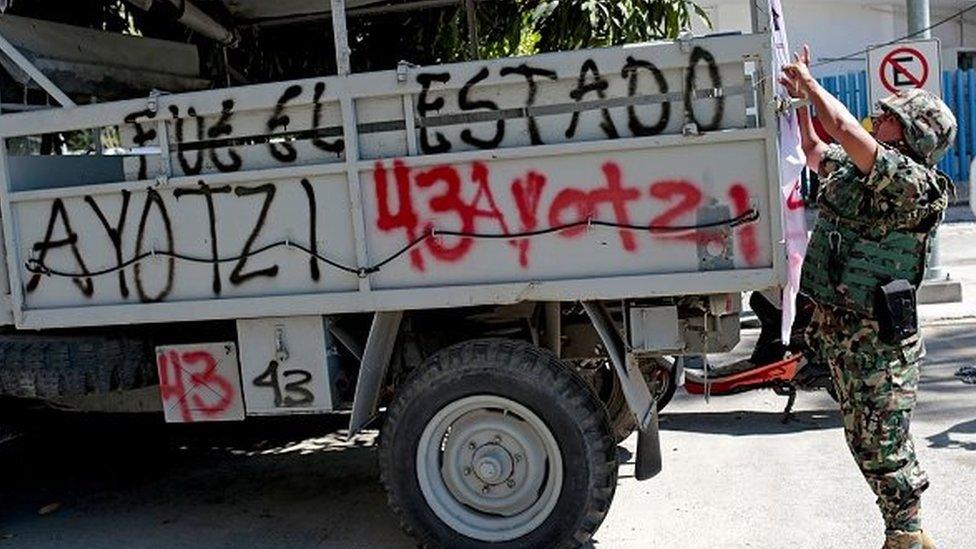
Many relatives think the army may have been involved in the students' disappearance
Many relatives have long suspected that students were taken to the local army barracks. They demanded access to the barracks months after their disappearance but were denied entry.
The government of President Enrique Peña Nieto, which was in power from 2012 until December 2018, refused to let the soldiers be questioned by anyone but government prosecutors, which raised suspicions among the relatives that there was a cover-up.
The drone footage showing marines tampering with the rubbish dump in Cocula has raised further suspicions about the possible involvement of the military in their disappearance.
Why did the students become a target in the first place?
There have been many theories.
Their left-wing activism and protests in Iguala had angered the mayor of the town at the time, José Luis Abarca, even before the night of the clash.
On the day the students came to Iguala, Mr Abarca's wife, María de los Angeles Pineda, was giving a speech at the town square, and there was speculation police were sent to stop the students from disrupting her event.
The couple fled the town after the students' disappearance and were later arrested in Mexico City. They are both in prison serving time for money laundering and links to organised crime.
Some of the other suspects arrested in connection with the case were freed after it was found that they had been subjected to torture and other human rights violations.
Related topics
- Published20 August 2022
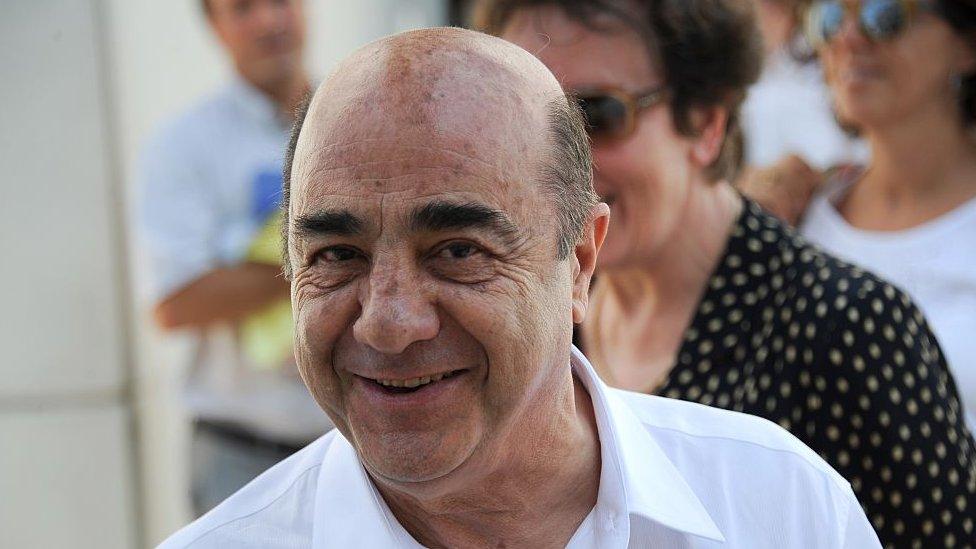
- Published16 June 2021

- Published8 July 2020
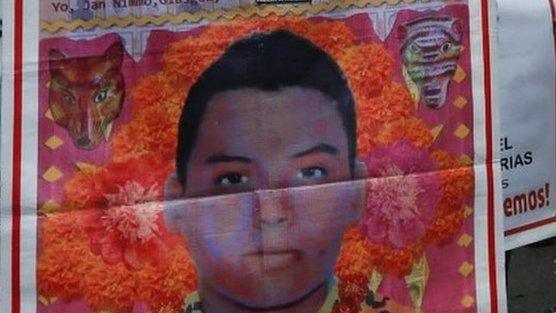
- Published19 September 2019
